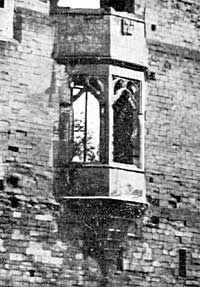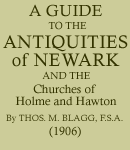< Previous | Contents | Next >

The Oriel Window.
THE ORIEL WINDOW.—Though this tranformation spoilt much of the early architecture of our Castle, both in the west wall and in the majestic gateway, it has given us one object of undeniable beauty. This is the elegant Oriel window which is so striking a feature of the present west front. This window also tells us who made these great alterations, and fixes their date; for above, on its face, hangs a shield bearing three stags trippant. The same shield, but with the charges defaced, though just discernible, being repeated inside the window on the north wall of the bay. These were the arms of Thomas Scot, of Rotherham, who was Bishop of Lincoln from 1471 to 1480, and as such, the whilom owner of the Castle. He was afterwards Archbishop of York (1480-1500), when he built the clearstory of Laxton church, in this neighbourhood, on the north side of which appears his effigy with his three stags at his feet. Throughout his life, in all the preferments he held, building appears to have been his hobby, and we know of many of his additions and alterations wherever he had property or interests.
The state room, lighted by the oriel window, though lacking the huge proportions of the old hall, was probably a very handsome apartment; it will be noticed that the ceiling of the bay is panelled with some mouldings, which have also been continued down the sides, though now defaced.
Standing in this oriel window, a fair landscape is outspread before us. Below is the river. On our immediate left the "elbow-bridge" of the towing path, the locks, the river-craft in the basin, and the red walls of old warehouses, have a picturesqueness of their own. Beyond them is the great water-mill, the successor of others which, on the same site, have been important adjuncts to Newark from Norman days downwards. The mill-tail and the waste water unite to flow under the elbow-bridge. Among the trees south-westward can be seen the brick turrets and gables of Kelham Hall, built by Sir Gilbert Scott in Italian Gothic style, once the stately residence of the Manners-Suttons, but now occupied as a Theological College. On the right is the long straight track of the Great North Road to York, and eventual Edinburgh, carried for a mile-and-a-half across the low-lying island to Muskham bridge, on a raised embankment pierced by a succession of flood arches, constructed by the engineer, Robert Smeaton, of lighthouse fame, in 1770.
THE DUNGEONS.—Entering a passage in the thickness of the north wall we descend to the Dungeons. The first of these is a rectangular vaulted pit, 12½ft. by 11ft. 6in., and 14 ft. high, lined throughout—floor, walls, and roof—with eighteenth century brickwork. It was used as an ice-house in recent years, when the Castle and its precincts were occupied by shambles and warehouses. In one or two places, where bricks have been removed, the original stone face of the wall can be seen. Climbing out of this we find, a few feet further down the passage, an "oubliette" or bottle-shaped dungeon, still more difficult of descent than the first. But by means of a ladder we squeeze down through a passage in the shoulder of the "bottle," and find ourselves in a circular pit immediately beneath the N.W. tower, 17 ft. deep by 10ft. 6in. in diameter, ventilated and lighted by a slit sloping upwards from its shoulder to the outer air on the tower face 15 ft. away. Round its sides can be seen the holes in which were fastened the iron rings which held the prisoners' chains.
FRAGMENTARY FEATURES.—In the basement room of the N.W. tower, in which the present caretaker and groundsman, Mr. Mountney, has collected many objects of interest, will be noticed some fragments of Norman mouldings, beak-head and chevron-and-pellet patterns, which have been found in the grounds, and here built into the wall for preservation.
THE MUSEUM.—Among the objects with a local association in Mr. Mountney's collection, or deposited with him, by the Corporation and various owners, are—
An iron cannon, found in 1879 in the river, near the "Star Fort," at Crankley Point.
An oval cannon shot, found in the west wall of the Castle in 1897.
A cannon ball, found in the river near the Viaduct bridge, S. Muskham.
A spinning wheel, removed from the Jersey School.
The Jersey School, one of the town's charities, was endowed by John Lilly in 1623, and girls were therein taught to spin until as recently as 1901, when the school was dissolved and the funds appropriated for purposes of other technical education for girls. The "plant" of spinning wheels was sold by auction for a few shillings each, but the Corporation deposited a typical specimen at the Castle.
THE RUSSIAN GUN.—The gun on the terrace is a 36-pounder, captured from the Russians at Sebastopol in 1855. Its former carriage having rotted away, the present one, of Sherwood Forest oak, was given by the late Earl Manvers.
A SUGGESTION.—The objects collected by the groundsman have been got together entirely on his own initiative, and even if it is desirable that more discrimination should be used between the collection of antiquities of really local association and the accumulation of miscellaneous "curios," great credit and thanks are, nevertheless, due to him for what he has accomplished with but small encouragement from others, and for the interest he takes in the fabric under his charge. Many antiquities found locally are available for deposit if only the town had a properly established museum in which to house them, and it is a pity the Corporation, or some patriotic burgess, does not restore the oaken floors to the chambers in the gatehouse. With their inner walls left rough, to show their architectural features, floors and roof and lattice casements in the windows are all that is required, when a legitimate piece of restoration would be accomplished, the town would be provided with a series of interesting rooms in which appropriately to keep its smaller antiquities, and the gateway arch thus roofed over would provide the public using the gardens with a much-needed shelter during showers.
